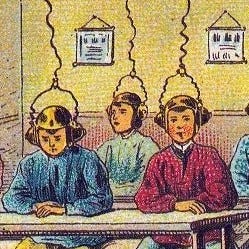Strategic Options
Once the potential implications of the scenarios have been distilled into the most relevant issues for each scenario1, it’s finally time to take the work of building plausible futures from the world external to the client (what might happen to them) and connect it with the client’s own agency (what they might do about it). This is done by designing strategies to best react to and cope with future possibilities in service of the vision. This is the second time in the process the client has been front and center; the first was when the project was framed and the client’s strategic needs helped inform what questions would be pursued and what the relevant scope would be.
The issues uncovered by the implications suggest potential states of affairs the client might face and be able to adapt to2. For each of these issues, one or more options can be generated - potential courses of action the client might take to prepare for and handle the issue. Think of approaching a sketch of an option like a pitch for venture capital: articulate the problem, propose what the client can do to react (and a memorable name for the work), and identify a miniature project plan that decomposes the work into a few logical phases with someone clearly accountable.
The scenarios themselves can guide which options to select to build a strategy. Rating the scenarios by their likelihood and the lack of preparation will show if some should be emphasized (those that are likely but the client is unprepared for) or minimized. Each option can be evaluated in terms of how well it would respond to the strategic environment posed by each scenario. Then a portfolio of options can be assembled into a strategy that appropriately weights the focus by scenario - is the client going to bet everything on preparing for one scenario, are they going to have a core focus with hedges for other possibilities, etc. For a different take on this process (building options more directly on the scenarios), and a great illustration of evaluating options in the scenario space, check out pages 9-11 in this GBN guide to going from scenarios to strategy by Erika Gregory, Gerald Harris, and Jay Ogilvie.
The term “options” is helpful for this work because it promotes both preparation and flexibility. One consequence of accepting that the future is wildly unpredictable is that the ability to monitor and pivot is its own source of value3. An article by de Ruijter and Janssen explicitly links the idea of a “real option” to financial options by defining it as the capability to take or refrain from a specific action for a certain length of time. That is, they are framed as an investment in future choice, so funding the capacity for a strategic decision in the future doesn’t require taking action if conditions aren’t favorable; this thinking can counteract the strong human bias toward the sunk cost fallacy. For example, instead of building a plant in an emerging market, a company might spend a year in the market with imported materials, getting a sense of conditions and deciding whether the plant would be viable.
Bonus Content: Professionalizing Foresight
A cool student presentation covered an article from our professor Andy Hines about professionalizing the field of foresight4. Because Futures is a field without professional standards, gatekeeping, or really even a definite name5, it’s hard to precisely define the field, keep out low-quality work6, or guide the field toward a larger positive impact. Credibility is important when Foresight work is a cost for the organization - the value needs to be clear or the function is likely to be cut when the business cycle takes a bad turn. One possibility that was suggested was that, during this time when DEI functions are being cut in the corporate world, maybe there will be an evolution toward a broader “values” function in organizations, and Foresight can fit in as part of how the business plans to implement its values in an uncertain future. One notable piece of progress toward professionalization I’m excited about: last month the Masters in Foresight at the University of Houston became the first program to be accredited by the World Futures Studies Federation.
To be transparent, I didn’t enjoy the process of imagining the implications (at all). The exercise of “what might happen?” was so broad as to be paralyzing. When I was building out the scenario logics/parameters, I had the twin constraints of keeping within the world of each driver and modifying it in line with the archetype. Maybe it would be better doing it as a group exercise, or maybe I need to investigate some alternate methods.
As a corollary, filter the issues to those the client has some agency or interest in responding to.
As a counterexample, consider the supply chain disruptions that happened at the beginning of the pandemic. For years, companies had been moving toward “just-in-time” inventory, shaving off costs by assuming that the future would be stable and predictable and keeping almost nothing on hand. There was very little resilience built into the system, and as soon as a confluence of problems occurred (work closures plus a ship wedged in a canal), it cascaded into general shortages as people started defensively purchasing things like toilet paper.
The article in the knowledge base is written by Andy alone, but the similar article I linked to is coauthored with Jeff Gold.
I alternate between Futures, Foresight, and Strategic Foresight, and I occasionally hear some holdouts sticking to Futurology.
Especially the kind of opportunistic, non-rigorous work that Alex Fergnani calls “charlatan futures”.



